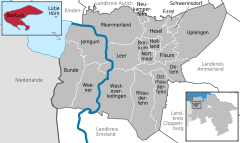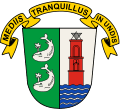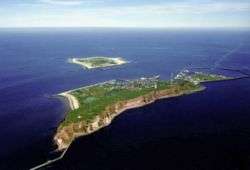Borkum
| Borkum | |||
|---|---|---|---|
|
Borkum photographed from a lighthouse | |||
| |||
 Borkum | |||
Location of Borkum within Leer district 
 | |||
| Coordinates: 53°35′17″N 06°40′11″E / 53.58806°N 6.66972°ECoordinates: 53°35′17″N 06°40′11″E / 53.58806°N 6.66972°E | |||
| Country | Germany | ||
| State | Lower Saxony | ||
| District | Leer | ||
| Government | |||
| • Mayor | Georg Lübben (Ind.) | ||
| Area | |||
| • Total | 30.74 km2 (11.87 sq mi) | ||
| Population (2015-12-31)[1] | |||
| • Total | 5,473 | ||
| • Density | 180/km2 (460/sq mi) | ||
| Time zone | CET/CEST (UTC+1/+2) | ||
| Postal codes | 26757 | ||
| Dialling codes | +49 22 | ||
| Vehicle registration | LER | ||
| Website | www.stadt-borkum.de | ||
Borkum is an island and a municipality in the Leer District in Lower Saxony, northwestern Germany. It is situated east of Rottumeroog and west of Juist.
Geography
.png)

Borkum is bordered to the west by the Westerems strait (which forms the border with the Netherlands), to the east by the Osterems strait, to the north by the North Sea, and to the south by the Wadden Sea. It is the largest and westernmost of the East Frisian Islands in the North Sea, due north of the Dutch province of Groningen.
The island was formed in 1863 by two previously separate islands which were still separated by a shallow water. The seam between the former eastern and western parts is called Tüskendör ("through in between").
History
Mentioned as Burchana fabaria (island of beans) by both Strabo and Pliny the elder, Borkum by the time of Charlemagne was part of a larger island called Bant, which consisted of the present day islands of Borkum, Juist, and the western part of Norderney.
In 1484, Bant passed to the Earls of East Frisia, who developed trade, and the island became known as a centre of piracy and whaling. By 1781, violent storms in the 18th century divided Bant into three islands. As whaling decreased, the inhabitants became impoverished, and many left, with the island's population falling from 852 in 1776 to 406 by 1811. The first tourists arrived on the island in 1834, and the local economy improved as a tourist resort.
In Mexico as I saw it, published by Thomas Nelson, Mrs Alec Tweedie, writing in 1911 about a trip of 1900 to Mexico, compares the brick roads of Monterrey with those of Borkum, "the one spot on earth from which Jews are banished". This had to do with the aggressive and successful campaign of German tourists to keep Borkum free from Jewish visitors, as celebrated in the antisemitic "Borkum-Lied".[2]
In 1910, British officers Captain Bernard Frederick Trench and Lieutenant Vivian H. Brandon were imprisoned for espionage for photographing the military installations on the island.
On 19 and 20 December 1934, Wernher von Braun launched "Max" and "Moritz", the two prototypes of the A2-rocket.
The island was the site of Nazi war crimes later prosecuted in the Borkum Island war crimes trial.
Transport
The island is partially car-free. Off-season, driving by car is permitted everywhere, otherwise there are car-free zones. The only town on the island is also called Borkum. There is an airfield in the Tüskendör area. Borkum is served by ferries from Emden, Germany and Eemshaven, the Netherlands. Passengers get a free train ride between the harbour and the town of Borkum.
See also
References
- ↑ Landesbetrieb für Statistik und Kommunikationstechnologie Niedersachsen, 102 Bevölkerung - Basis Zensus 2011, Stand 31. Dezember 2015 (Tabelle K1020014)
- ↑ "Wir grüßen heut' im frohen Lied (antisemitisches Borkum-Lied)". Volksliederarchiv (in German). Retrieved 20 December 2011.
External links
| Wikimedia Commons has media related to Borkum. |
 "Borkum". Encyclopædia Britannica. 4 (11th ed.). 1911.
"Borkum". Encyclopædia Britannica. 4 (11th ed.). 1911.- Official site (German)
- Web-Directory with the topic Borkum (German)
- Web-Directory with the topic Borkum's summer residence (German)



